A good, healthy sourdough starter is key to delicious sourdough bread. But what if you don’t have time to catch a wild starter? Here is how to use milk kefir or kombucha to make a sourdough starter in 24 hours.
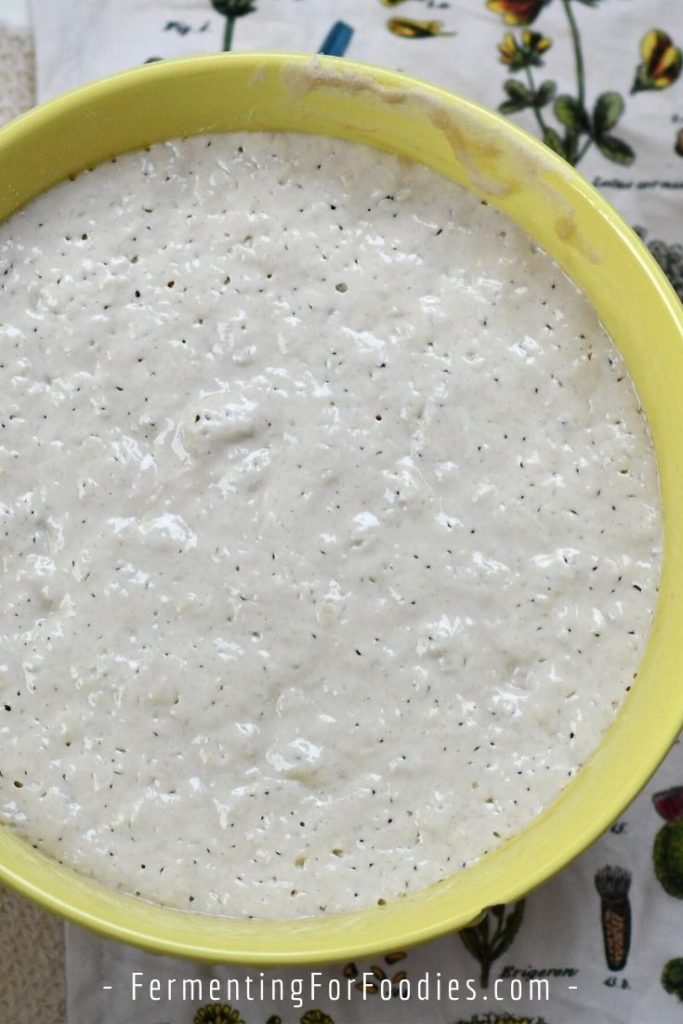
Struggles with Sourdough Starter
There are a number of reasons why it can be difficult to catch and maintain a healthy traditional sourdough starter.
Sometimes starters take too long to become active or never become very vigorous. They can grow mold or turn pink (that has happened to me). Or starters can look healthy and bubbly but have a bad flavor.
Here are a few of the main reasons why sourdough starters can be tricky:
- Regional variations in wild yeast: There’s a reason why we think of San Francisco sourdough and not Dallas sourdough… some regions just have better-tasting wild yeasts. However, even if you buy a San Francisco sourdough starter online, it will quickly be taken over by the local varieties of yeast.
- Poor air quality: If you live in a heavily polluted city or have problems with mold in your home, then you may have trouble maintaining a healthy sourdough starter.
- Filtered air: Using a HEPA filter in your home will greatly reduce the wild yeasts and bacteria that can colonize your starter.
- Type of flour: Certain flours, like buckwheat, naturally have symbiotic yeast. They are great at catching sourdough culture. However, other flours like rye, barley, and rice are more difficult to catch and maintain. It isn’t impossible, as my husband regularly keeps a rye starter, however, his rye starter is never as vigorous as my buckwheat starter.
An Easy Sourdough Starter
If you are struggling to keep a healthy sourdough starter, or if you don’t want to wait for 5-7 days to develop a healthy starter there is an alternative way to kick-start your sourdough.
Start your sourdough starter with a culture that already contains active yeast and bacteria!
There are a number of different fermented beverages that are made with a SCOBY (Symbiotic Colony Of Bacteria and Yeast):
Each of these beverages can be used to make a quick sourdough starter. They will each bring their own flavor and qualities to the loaf, however, they will create a bubbly, yeasty, and fermented starter.
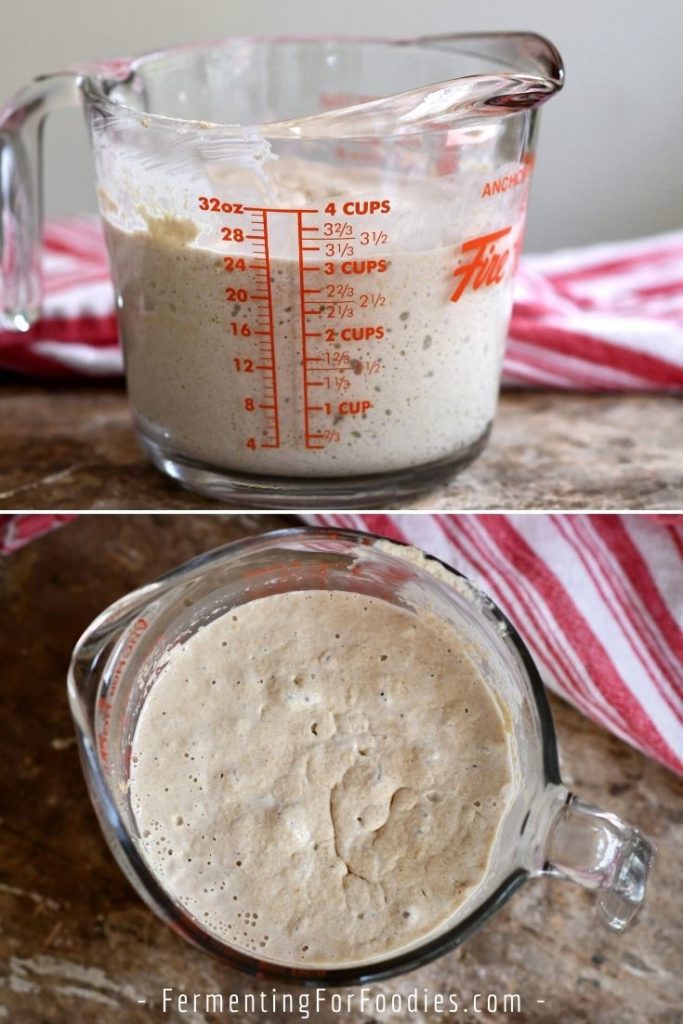
How to use a kefir or kombucha sourdough starter
There are two ways to use this quick sourdough starter recipe. Either as a quick single-use starter or to kickstart a traditional starter.
Single-use starter
It’s perfectly fine to make a quick sourdough starter every time you want to bake with sourdough. This is a perfect option for anyone who regularly brews kefir or kombucha.
Here’s how to use a single-use kefir or kombucha sourdough starter:
- Mix up exactly the required amount of starter required for the recipe.
- Let the mixture ferment for at least 24 hours before use.
- I also recommend adding a small amount (1/4 tsp) of commercial yeast to provide a bit more boost to your bread.
Kickstarting a traditional starter
Our sourdough journey began in the early 2000s when Brad got a copy of the Tassajara bread book. That book recommended making a starter out of whatever you had going sour in the fridge. Personally, I think using a fermented beverage is a much more reliable way to kickstart a traditional starter.
This is especially helpful for anyone who regularly makes kefir or kombucha. Because your indoor air is quite likely teaming with the yeast and bacteria from your existing ferments, those would naturally be the first to culture your sourdough.
Here’s how to use kombucha or kefir to make a traditional starter:
- Stir the flour and kombucha (or kefir) mixture twice a day for 2 days (48 hours) to bring air into the culture.
- After 48 hours, feed your starter equal parts flour and water. There’s no need to add more kombucha or kefir.
- Follow the regular feeding and maintenance for a traditional sourdough starter or gluten-free sourdough starter.
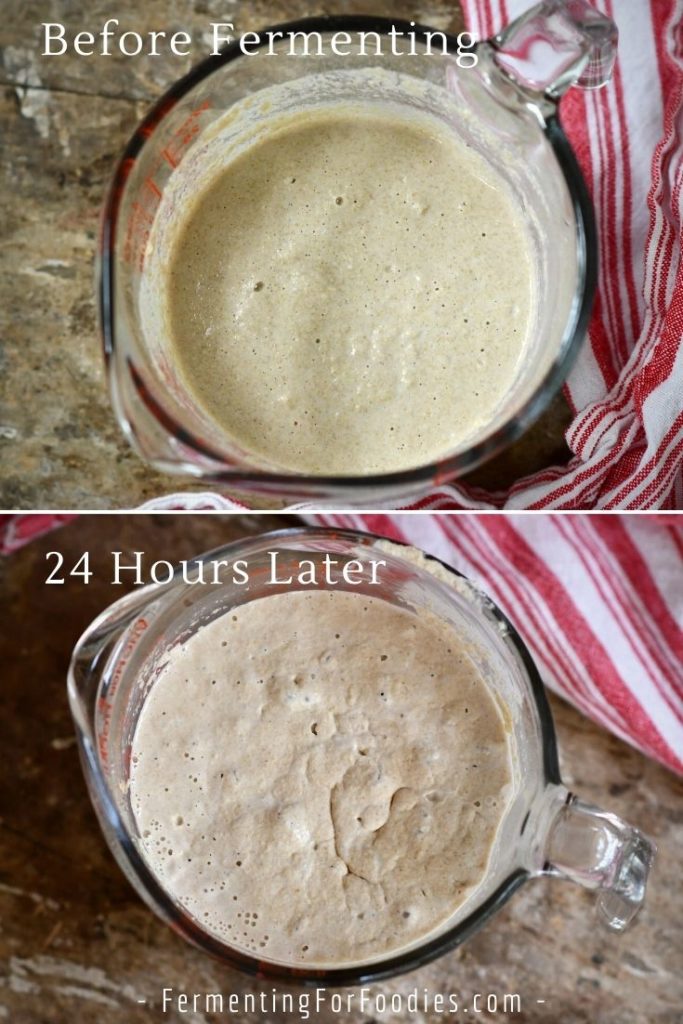
Quick Kefir or Kombucha Sourdough Starter
Get a jump on your sourdough bread with kombucha, milk kefir, water kefir, or jun. Using a yeast-based culture will result in a vigorous starter in just 24 hours. Perfect for anyone struggling to make traditional sourdough bread.
- Prep Time: 5 minutes
- Total Time: 5 minutes
- Yield: 1/3 cup 1x
- Category: Bread
- Method: Sourdough
- Cuisine: Simple
- Diet: Vegan
Ingredients
- 2 oz flour (or 1/2 cup depending on the weight of the flour)
- 2 oz fermented beverage (1/4 cup, see section above for options)
Instructions
- Mix equal parts (by weight) of flour and a fermented beverage in a glass container.
- Loosely cover with a tea towel and leave in a warm spot. Near a heater or above the fridge works well.
- Stir vigorously twice a day until ready to use. This brings air into the ferment and prevents crusting. Let it ferment for at least 24 hours and up to 72 hours (3 days).
Notes
- The best beverages to use are either milk kefir or an unflavoured kombucha. Don’t include the actual SCOBY or grains. The fermented liquid will have enough yeast and bacteria to kick start the sourdough starter. However, avoid using off-the-shelf grocery store kefir and kombucha. They usually don’t contain active strains of yeasts.
- Most sourdough bread recipes require a 100% hydration ratio for the starter. (Meaning equal portions of water and flour by weight.) This is easiest to do with a digital scale
that has a zeroing function. If you have to measure the ingredients by volume then remember that whole grain flour is heavier than white flour.
- This quick sourdough bread method will work for gluten-free recipes as well! Just use a gluten-free bread flour mix and GF bread recipe.
- See the section above for information on how to feed and maintain this type of sourdough starter.
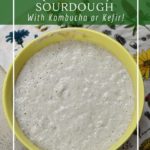
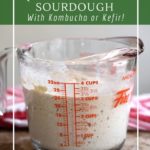
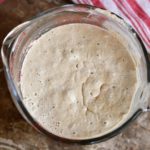
I have tried this and left it for 1 week, it hasn’t gone off but there are no bubbles, what would you recommend? Thanks
That is surprising because it should only take 1-2 days. After a week you should have at least caught a free range sourdough culture! Did you use homebrewed kefir or kombucha? Because store-bought often doesn’t contain much “live culture” or at least none of the yeast culture.
If it hasn’t gone off, does it at least smell good? If it smells good then bake with it using some instant yeast as back up.
Ah that may be it -it is store bought but says it contains live culture. I will try it anyway. Thanks!
If I have prepared the sourdough using water kefir successfully, pls may i know how to make a loaf of bread . Pls may i have a bread recipe. Thank you
Hi Pauline,
I have exactly the same autoimmune reaction to gluten. And have been gluten free for over 10 years. I have a ton of recipes for GF sourdough and breads, etc. Using buckwheat or teff will create a very healthy sourdough starter without added culture. They both have their own yeast that is right on the grain. Here’s a recipe: https://www.fermentingforfoodies.com/gluten-free-sourdough-starter/ And recipes for bread: https://www.fermentingforfoodies.com/category/types-of-ferments/gluten-free-sourdough/
Cheers, Emillie
Hi once bubbling after say 72 hours do I just maintain the starter as per your other starter instructions ie dump and feed?? Please let me know thank you Raelene
Yes, you can maintain it just like a regular sourdough starter. It will continue to be happy and bubbling as long as you keep feeding it.
Thank you for letting me know . I used fresh mulled buckwheat and the recipe weights but it is quiet a thick paste, what consistency should it be? Should I add a little more water kefir?
Buckwheat usually ferments quite well. So I’m sure it will work out, even without extra water kefir. Try to make it the consistency of a thickened sauce. I find that buckwheat absorbs a lot more water than other grains, so you will probably need to add extra. If it’s already bubbling, then just add water. Otherwise, you could add water kefir. Good luck!
Dear Emillie, thank you for your recipe. Silly question as you more likely have already answered, I just prepared the mix of home made kefir and and strong white organic flour, I suppose I will know when it’s ready as it will double in volume? Use it then for my first bake experiment and Irefrigerate it until the next use? By treating it as other starter do you mind same kind and quantity of flour and plain warm water? Thanks a million from London .
Hi, It probably won’t double in volume. However, it will be bubbly and have increased in size after about 24 hours. Then you’re good to bake! As for future baking, with this recipe, there are two choices. Either make exactly what you need, each time you want to bake. Or keep feeding it water and flour and store it in the fridge between uses just like a traditional starter. To get it to catch like a traditional starter, you’ll need to leave it out and feed it for a few days to really get it going the second time you want to bake with it. Enjoy!
❤️
Thank you Emille! My previous 2 attempts of making one from scratch in a traditional way didn’t work, however I’ve been making my own kefir for a couple of years, so it might be the right solution
Great! Hope this is the right solution for you!
Hi, still very new to the sourdough world. Just wondering- once I have it started with the milk kiefer and flour and it’s ready, and after I dump the scraps, do I feed it with MORE milk keifer and flour or just water and flour?
Just keep it fed like a typical sourdough starter, on water and flour. If it doesn’t do well, then you just need to keep at it. Sourdough is mostly fed by your local strains of yeast and bacteria. It can take a while (2-3 months) to establish a good local culture.
Good luck!
Hello,
I really love this idea of using water kefir as a sourdough starter, I lived in the jungle previously and had high humidity-it didn’t work for me ever. I’m in a much dryer climate but I am at 1,400 meters above sea level-does this change anything? Another thing is I tried last week to do this, but after 3 days it wasnt really bubbling a lot. Read about the float test and it failed. So today I have tried again. When using the water kefir, you’re talking about the F1 batch or the 2F batch? Thought I’d ask. Are there recipes that call for this little amount of sourdough starter to make bread or is this to keep alive and keep feeding? Thank you
Hi Hannah, I would use the unflavoured first ferment, but if you think it’s a little too sweet, then do a second ferment, just without any additional sugar or flavour. All you really want is the yeast!
You can kickstart sourdough this way, and try to keep it going. However, if the conditions in your house make it hard to culture sourdough, then it may be hard to keep it going. So just start new a few days before you want to bake. At 1400 meters, it might be too dry for sourdough. Also, some climates are just not sourdough friendly.
Most of my gluten sourdough recipes call for very little starter, however, my GF recipes use more starter. The recipe can be scaled, so just make whatever you need. Let me know how it works out for you.
Cheers, Emillie
Hi there, I’m completely new to fermenting bread, so I need a bit of guidance. Once my sourdough Is complete (I’ll be making it with milk keffir) then I’ll have to feed it everyday? And will I have to do always the equal parts of keffir and flour or should I do just with water?
I designed this recipe so that you make just what you need to bake right away. Then start over again the next time. If you want to keep the starter alive, I recommend feeding it with water and flour and it will slowly transform into a traditional sourdough starter. Here’s how to feed a traditional sourdough starter: https://www.fermentingforfoodies.com/sourdough-starter/
Enjoy!
Hi Emillie, I made extra dairy kefir so I could start this today. Thank you for doing this, I’ve passed your site on to other friends with the recent surge in interest for all things fermented.
I want to make your Pain de Campagne bread, but the recipes asks for 1-1/3 cups sourdough starter, and the quick and easy starter says it will yield only 1/3 cup. Do I just divide the bread recipe in 4 and only make one smaller loaf? That’s fine because I’m only one persona and 2 big loaves would be a lot! Or am I missing something?
Hi Carolyn, Thanks for sharing my website! I designed this recipe so that it could be scaled to suit whatever your recipe might need. Are you able to mix together a bit more sourdough for the full batch of bread? Alternatively, you could try making a 1/3 batch. Especially if it’s your first time. Sourdough bread does take a bit of feel and learning, so a small batch isn’t a bad idea. Cheers, Emillie
1/3 batch is the route I’ll take. Thank you!
How did it work out?
Bread is good, not as pretty as yours, need to work on folding technique, but tasty.
I can’t figure out how to add a picture here.
My anti-spam software won’t let you send a picture. You can do it via Facebook or pinterest! Glad it worked out. I’ll admit that Brad has been perfecting his bread making since 2002! So he’s pretty good at shaping by now. 🙂
Hello Emillie,
With this kombucha sourdough starter, does it then make a 100% hydration starter?
Thank you!
Yes, its based on 100% hydration. Feel free to adjust as you want!
So I have a great Kombucha starter going, just wondering if I use it with regular “sourdough” recipes at the same measure? If the recipe calls for 1 C of sourdough starter, it would use 1C Kombucha starter?
Yes! I just recommend boosting the yeast with a 1/4 tsp of commercial yeast, since it’s not exactly the same as regular sourdough and doesn’t have quite the lift.
When do you add the 1/4 tsp of yeast? When making the bread, or do you add it to the starter? If you make add it to the starter, at what point is it added? THANKS!
Hi Becky, add the yeast to your bread recipe. This starter will give the bread flavour and some loft, but not as much as a traditional sourdough starter (hence the little boost of extra yeast). Cheers
Hi!
You’ve mentioned not to use store bought cultures for this. How or where do I get the water kefir or unflavored kombucha?
Also, (just my luck) I’m allergic to rice and buckwheat. Do you know of any other combinations that would make a good bread?
Thank you!
Hi Rachel, if you’re not already making your own water kefir, kombucha, etc. then you might want to make a traditional GF sourdough culture. I do most of my favourite GF baking with oat flour, in part because rice doesn’t agree with me either, but also because oats are naturally sticky and bake up nicely. You can find my gf sourdough culture recipe here: https://www.fermentingforfoodies.com/gluten-free-sourdough-starter/
It will take about a week, but should work. Good luck!
Hi, thanks for this great site and information ! I have started a sourdough starter with wholemeal spelt flour and water kefir. The mix was very thick so I added more kefir water to make it more like a thick sauce as per your answer to a previous comment. After about 12 hours now it is very sticky and a little bubbly but it seems to have split so that I have a thin layer of liquid on the buttom and underneath a layer of flour mix that seems to not be bubbly at all. Would you have any suggestions what I did wrong? Can I just try to take out only the top part and continue with that maybe?
At this point, you should just stir it in. That sometimes happens as flour settles, and likely means you have a bit too much liquid, or perhaps the spelt hasn’t absorbed it well (which can happen with whole grain flour). Luckily, sourdough is very forgiving. Enjoy!
Hi,
Thank you for your recipie. I happen to have followed another sourdough starter recipe (with yeast, flour and water) and while the first loaf was good, I’m now struggling to get any proper sourdough out of it… (I store it in the fridge and feed it weekly with a little sugar)
I was wandering if I could add a bit of home made kefir to ‘revive’ it or should I discard it and start oll over again…?
Thanks a mil!
Hi, I think you have two options… either make a new starter every time you want to bake bread (with kefir and flour). Or you can start feeding it like a regular sourdough starter.
To feed it like a regular sourdough starter, you’ll need to give it flour and water. Sugar just feeds the yeast and you want to feed both the bacteria and the yeast. To really revive this starter, you’ll need to take it out of the fridge for a few days and feed it flour and water every day. Approximately half its volume of flour and water, but you don’t need to be super accurate. Good luck!
Will try your second suggestion. Thanks for taking the time to respond so quickly!
Will definetly try a kefir starter next time…
Best
I have made Sourdough bread over 20 years ago but since then I have had to go on a gluten free dairy free diet. I would like to make my own sourdough again. Is this possible.? I also would like to learn about the other SCOBYS that you talk about as I am new to fermentation.
Hi Sharon, I’m actually 100% GF! I have been for at least 10 years. So I only have a few wheat-based recipes (sort of required for a fermentation website) but all regular my baking and not-bread sourdough baking is actually made with GF ingredients. 🙂 I recommend making a typical sourdough starter with GF flour. You can find out more here: https://www.fermentingforfoodies.com/gluten-free-sourdough-starter/
Enjoy!
Hi, thank you so much for your recipe. I am kind of new with my milk kefir and really wanted to try this recipe out. Can you tell me if I am meant to use the whey produced from the milk kefir or use the kefir it self. Many thanks for all your help. Kind Regards
Either would work. I’ve used both and it’s worked out. 🙂
Hi Emillie! Thank you for writing out this post 🙂
You mentioned about after mixing 1:1 ratio of the cultured to flour, leave it for at least 24hours to 72hours. Does it mean I don’t need to feed it after mixing it the first time?
Yes… this recipe is designed to be used right away. However, if you want to keep the starter you will need to feed it water and flour after 72 hours. Good luck!
How do I make kifger milk?..
Here’s my basic milk kefir recipe: https://www.fermentingforfoodies.com/easy-homemade-milk-kefir/ The hardest part is probably finding the grains. There are a few facebook culture sharing groups that might help. Cheers, Emillie
Hello. Like some other folks, I am new to all of this and find your blog very interesting. I have been making milk kefir and would like to try this. I am not allergic to wheat gluten but usually avoid gluten and am wondering if using oat flour with this quick method will work, or does it need to be glutinous flour? I had plenty of kefir so I mixed it up by weight, so I guess I’m now asking if I can expect anything to happen with it. Ha! I have read your post for the GF sourdough starter and just started that yesterday with oat flour, as well. Both of the starter mixtures look very very thick. Thanks in advance for your help.
Hi! I’m actually GF (allergy not celiac, so my husband does my wheat recipes). Oat flour tends to get thicker as it soaks, whereas wheat tends to get thinner. I try to write most of my recipes so that the thickness of the soaked flour can be adjusted for by adding extra flour as needed. This is even more important with GF baking since there are so many flour options. Quick milk kefir starter will definitely work with oat flour. While I’m currently on a sourdough kick at the moment, I’ve done this quick method for both gluten and gluten-free baking hundreds of times.
Glad you enjoy the blog!
Thanks for your reply!! I ended up using the GF sourdough starter to make the cinn bun recipe today, and while they looked great and the taste was good, they didn’t rise nearly as much as yours. The starter was with oat flour and I used “cup for cup, ancient grains (gf) to make the dough, which contains oat flour in the mix. I will try again. For this recipe do you advise using the stretch and fold method? Do you always do that with any sourdough recipe?
Stretch and fold only works for gluten bread. GF flours don’t have the necessary structure. I haven’t used cup for cup myself, but I’ve seen others bake with it and works really well. Did you use the added bread yeast for the cinnamon buns? I really find that GF flours need a bit of extra boost. My only other thought is whether the ancient grain blend contains oat flour (like your starter)… because each grain seems to have its own sourdough cultures and they really can’t switch between types of flour.
Cheers, Emillie
HI. Yes, I used the yeast called for in the recipe and yes, the cup for cup ancient grain mix has oat flour in it. Listed first in ingredients I believe. I’ve used the regular cup for cup for a long time but liked the idea of this newer ancient grains blend for better nutrition and, as you say, taste. The dough came together well and was relatively easy to work with, unlike a lot of gf recipes. I did wish the cinn buns were more moist after baking. Not sure how to remedy that and still have a stiff enough dough? If these flours weren’t so expensive I would be more brave to experiment! It is always really helpful to read comments and questions from others. Like I said, I will try this recipe again and some of your others! Thanks for your help!
I’ve found that dryness in gf baking is often due to the flours. Sometimes, even the specific brand of flour makes a difference. For example, buckwheat can be moist or dry, and I’m not sure what makes the difference, likely subtle changes in the carb to protein ratio. Cheers!
HI. Wasn’t sure my question went through so I’m sending again… like others I am new to all of this and find your site very interesting. I’ve been making milk kefir and would like to try the quick start method and am wondering if the flour needs to be glutinous in order to work? I’m not allergic to wheat gluten but try to avoid and wanted to try with oat flour. I mixed up the GF sourdough starter with oat flour and water yesterday, but wanted to experiment with using kefir since I have it on hand. I mixed oat flour and kefir this morning, by weight. Both this mix and the water/oat flour one are extremely thick. So my questions are about the consistency and whether or not the kefir/oat flour mix will lead to anything. Ultimately I”d like to make your GF cinnamon roll recipe, so I mixed up enough for that. Have not had good cinn buns without gluten… Thank you in advance for your advice!
I had good results making a 100% hydration starter:
54g water kefir that had both the primary and secondary ferments
54g bread four
I mixed these and fermented for 18 hours in a 25 degree C proofer. The starter doubled in volume and there were many bubbles on the top. It looked quite active.
I used this to make a 45% whole-wheat and 55% bread flour loaf. I did a 7 hour bulk ferment and a 2 hour proof–both also in the proofer–and the results were excellent. I had a good rise and a good texture without adding any commercial yeast. It didn’t rise real much during fermenting/proofing, but I had a good oven spring.
Hi Jeff, Sorry your comment didn’t post right away. For some reason, it went into my spam folder. Glad you had good results with a kefir sourdough! I’m actually baking a loaf myself right now. Sometimes it’s nice to take a break from maintaining a regular starter. Be well, Emillie